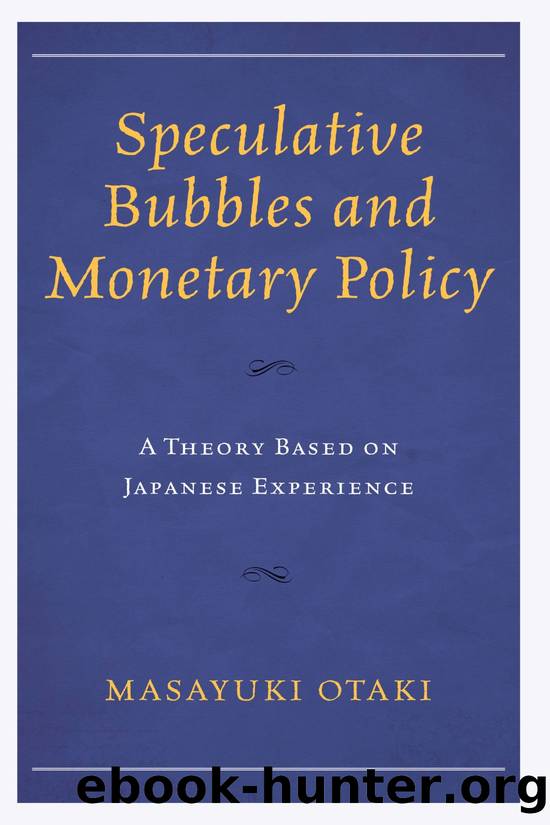Speculative Bubbles and Monetary Policy by Otaki Masayuki;

Author:Otaki, Masayuki;
Language: eng
Format: epub
Publisher: Lexington Books/Fortress Academic
Part II
THEORY
Chapter 2
A Conundrum in Monetary Economics
Does Keynes Abandon the Second Postulate of Classical Economics?
ABSTRACT
This chapter examines how an idle production resource such as involuntary unemployment is provoked. Traditional Keynesian theory, which includes menu cost theory, violates the second postulate of the classical school. It should be noted, however, that Keynes extends that postulate rather than denying it. I show that price stickiness assumption is unnecessary but that the separation of aggregate demand from supply is vital. The problem of double coincidence of wants establishes such a separation. By deploying an OLG model with money, this chapter clarifies how involuntary unemployment is caused under the flexible price assumption.
2.1 INTRODUCTION
Many economists consider that the second postulate of classical economics, which asserts that the marginal disutility of labor is equalized to the real wage, should be abandoned to induce the existence of idle production resources (i.e., involuntary unemployment). The traditional Keynesian approach assumes that significant costs for realignment make the nominal wage insensitive to a change in the price level. Since this school regards that the price level is determined to equilibrate the goods market, the price level rises along with an autonomous increase in the aggregate demand. Accordingly, the real wage falls and thus labor demand increases. However, to the extent that the second postulate is not abandoned, such a reduction in the real wage discourages the aggregate labor supply. Thus, there is a contradiction and the second postulate should be discarded to show the existence of involuntary unemployment.
In the context of the menu cost theory, which originates from Blanchard and Kiyotaki (1989), traditional Keynesian theory can be interpreted as positing a substantial menu cost exists in the renegotiation of the nominal wage. As I shall show in section 2.2, the same property emerges as that in Blanchard and Kiyotaki (1989) if such a menu cost in the nominal wage negotiation exists (note that the price-staggering model in Gali (2008) implicitly assumes that prohibitive menu costs are incurred when a firm revises its offer price in a disorderly fashion).
In other words, this fact implies that menu cost theory belongs to the same category as traditional Keynesian theory in its exogenous introduction of a price stickiness assumption. Consequently, both theories violate the second postulate of the classical school.
In contrast to the traditional Keynesian theory including menu cost theory, Keynes (1936) emphasizes that a reduction in the nominal wage is only associated with a proportionate fall in the price level, and thus is neutral to the equilibrium employment level. His logic is as follows: According to elementary economics, the employment level is determined by the level at which marginal cost (product of the nominal wage and the inverse production function) is equal to marginal revenue (output price); hence, if the output price hike is proportionate to the nominal wage, the employment level is kept unchanged because the real wage is unaffected.1
How does this assertion of Keynes relate to the second postulate of the classical theory? According to Keynes (1936, 14â15)
whereas they [workers] do
Download
This site does not store any files on its server. We only index and link to content provided by other sites. Please contact the content providers to delete copyright contents if any and email us, we'll remove relevant links or contents immediately.
International Integration of the Brazilian Economy by Elias C. Grivoyannis(91281)
The Radium Girls by Kate Moore(11921)
Turbulence by E. J. Noyes(7936)
Nudge - Improving Decisions about Health, Wealth, and Happiness by Thaler Sunstein(7615)
The Black Swan by Nassim Nicholas Taleb(7010)
Rich Dad Poor Dad by Robert T. Kiyosaki(6405)
Pioneering Portfolio Management by David F. Swensen(6226)
Man-made Catastrophes and Risk Information Concealment by Dmitry Chernov & Didier Sornette(5921)
Zero to One by Peter Thiel(5686)
Secrecy World by Jake Bernstein(4646)
Millionaire: The Philanderer, Gambler, and Duelist Who Invented Modern Finance by Janet Gleeson(4376)
The Age of Surveillance Capitalism by Shoshana Zuboff(4210)
Skin in the Game by Nassim Nicholas Taleb(4162)
Bullshit Jobs by David Graeber(4095)
The Money Culture by Michael Lewis(4076)
Skin in the Game: Hidden Asymmetries in Daily Life by Nassim Nicholas Taleb(3929)
The Dhandho Investor by Mohnish Pabrai(3699)
The Wisdom of Finance by Mihir Desai(3654)
Blockchain Basics by Daniel Drescher(3507)
